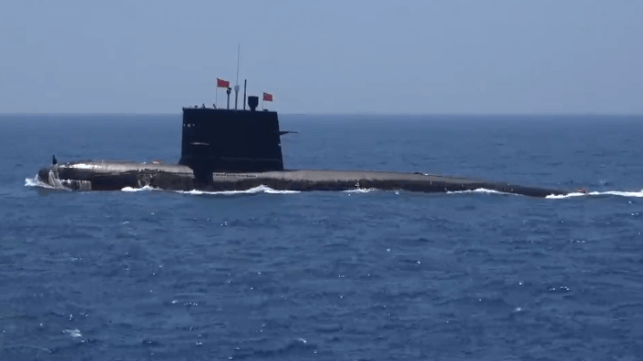Is Russia Helping China Build a Hybrid-Nuclear Submarine?
[By Dr. Sarah Kirchberger and CAPT Christopher P. Carlson, USN (Ret)]
On September 27, 2024, news broke that a previously unreported new type of Chinese nuclear-powered submarine, dubbed the “Type 041,” had suffered a major mishap at its fitting out pier at the Wuchang shipyard in Wuhan, according to unnamed Pentagon sources. Submarine expert Thomas Shugart had previously spotted an unknown submarine with a distinct x-shaped stern at Wuchang Shipyard from satellite imagery taken on 26 April 2024, and days later reported unusual crane activity at the same pier location from June 2024 imagery, speculating that the new boat suffered a serious incident.
Even more intriguing and consequential than the question of whether a submarine incident of some sort actually did occur at Wuchang or not, is however another issue: What type of “nuclear-powered submarine” could this new design possibly be?
China watchers were quick to point out that the Wuchang Shipyard in Wuhan had not hitherto built any nuclear submarines, although the shipyard’s facilities were completely rebuilt at a new location (from 2012-2020) and massively enlarged. All Chinese nuclear-powered attack submarines (SSN) and ballistic missile submarines (SSBN) have so far been constructed exclusively at the Bohai Shipyard at Huludao. The imagery of the new submarine makes it clear it is too small for a SSN, and is similar in size to China’s Type 039A/B/C Yuan series of conventionally powered submarines. Another interesting indicator was the reported type number – “041” – which is a continuation of the traditional numbering scheme carried by China’s diesel-electric submarines. By contrast, China’s nuclear-powered subs, whether SSNs or SSBNs, all have official type numbers starting with “09.” The next-generation Type 095 SSN and Type 096 SSBN are possibly already under construction at the Bohai Shipyard in Huludao, and there is no plausible suggestion that the smaller, unknown boat observed in Wuhan could represent either of those two platforms, given the larger estimated displacement of the Type 095 and Type 096 compared with the previous generation of Chinese SSNs and SSBNs.
…looking at multiple images of it, also appears to have an X-stern, a feature not seen before on any Chinese submarine.
Measuring to the X-stern, what we can see of the new boat is over 80m long, compared to ~77m overall for the 039A. I’m guessing it’s around 83-85m overall. pic.twitter.com/RUE1qIMA1q
— Tom Shugart (@tshugart3) July 28, 2024
A new type of nuclear battery AIP propulsion?
It would have been easy to dismiss the news of a supposedly nuclear-powered Type 041 submarine built in Wuhan as misinformation, were it not for the fact that several years earlier Chinese sources had hinted at a project for developing small, low power auxiliary nuclear reactors for conventional submarines, replacing the Stirling engine air-independent power system (AIP) that China developed based on a technology transfer from Sweden during the 1980s. A 2017 report by Richard D. Fisher described some details of such a plan based on slides from an academic lecture given by retired Rear Admiral Zhao Dengping.
Despite successfully developing a Stirling engine-based AIP system, China is known to have struggled with developing a more advanced, fuel cell-based AIP system as is currently in use with the German, South Korean and Singaporean navies, among others. Neither has China deployed lithium-ion batteries aboard its submarines, as pioneered by Japan. Here, Chinese analyses have stressed unresolved issues regarding the danger of thermal runaway, which poses heightened risks of a severe fire aboard a submerged submarine.
In light of such technical challenges, China may have decided to forgo developing high power density fuel cells or even more powerful Stirling engines for submarine applications, even though lithium-ion batteries are probably still on the table, opting for a different solution altogether by developing a nuclear battery.
Interestingly, as reported by R.D. Fisher, Rear Admiral Zhao Dengping’s lecture slides described just such a nuclear battery project. Of the presentation slides posted online, three dealt specifically with a small-scale nuclear reactor for conventional submarine platforms. One slide showed a basic schematic diagram that depicted a possible layout of the nuclear-powered electric propulsion plant. The reactor itself is described as a low pressure, low temperature design that employs natural circulation in the primary loop. Steam is generated, however, through an intermediate loop that appears to be in a separate compartment, which is then sent to a secondary loop with a conventional steam driven turbine generator in yet another compartment. While this design suggests an emphasis on safety, it does so at the expense of internal volume requirements and thermodynamic efficiency.
It is reasonable to ask if these slides accurately reflect Chinese intentions. With the benefit of hindsight, the response would be a confident “yes” because every slide posted from RADM Zhao’s lecture showed a platform or system that was then in service, undergoing testing, or was in the advanced research and development stage. For example, Zhao presented a slide that discussed a large deck amphibious assault ship – larger than the Type 075. The computer-generated graphic on the slide is very similar to the Type 076 currently under construction at t…
CONTINUE READING THE ARTICLE FROM The Maritime Executive HERE



Comments are closed, but trackbacks and pingbacks are open.